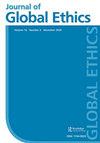The Other – a troublesome dyad?
Q2 Arts and Humanities
引用次数: 0
Abstract
The ‘Other’ can be near to us, or far from us. We are in-relation with both. Given that, we explore whether, from a moral philosophical perspective, the ‘near-other’ is in tension with the ‘far-other’. We argue that we find our relationship with the near-other through a transcendent metaphysical empathy derived from the noumenon, which is manifest in the phenomenon as compassion and justice. We then argue that perceived differences in the phenomenon mean that we do not reliably transfer this empathy for the near-other, to the far-other. Further, empathic and constructive dialogue is made more difficult because of our proclivity to actively engage in ‘othering’ those not-like-us. Properly, moral decision-making is positioned in a space cognizant of the other. Near-otherness makes consensus in the decision-making process easier, while far-otherness makes consensus more difficult. In our post-modern, multicultural and multifaith era, we need to be alert to the other’s perspective, to find a way to have a meaningful dialogue and thus achieve consensus in our moral decision-making.他者——一个麻烦的二分体?
“他者”可以离我们很近,也可以离我们很远。我们与两者都有关系。鉴于此,我们将从道德哲学的角度探讨“近他者”与“远他者”之间是否存在张力。我们认为,我们发现我们与近他者的关系是通过一种超然的形而上学共情,这种共情源于本体,表现为同情和正义的现象。然后我们认为,这种现象的感知差异意味着我们不能可靠地将这种对近他者的同理心转移到远他者身上。此外,移情和建设性的对话变得更加困难,因为我们倾向于积极地参与“其他”那些不喜欢我们的人。正确地说,道德决策被定位在一个认知他人的空间中。近他者性使决策过程更容易达成共识,而远他者性使共识更难达成。在后现代、多元文化和多信仰的时代,我们需要警惕他人的观点,找到一种有意义的对话方式,从而在我们的道德决策中达成共识。
本文章由计算机程序翻译,如有差异,请以英文原文为准。
求助全文
约1分钟内获得全文
求助全文

 求助内容:
求助内容: 应助结果提醒方式:
应助结果提醒方式:


